Why this resume works
- Quantifies accomplishments: Measurable accomplishments, such as improving student performance by 20%, highlight the applicant’s strong teaching methods.
- Highlights industry-specific skills: Skills like differentiated instruction and educational technology highlight the applicant’s readiness for modern classrooms, aligning with industry-specific needs in education.
- Illustrates problem-solving ability: Implementing technology-improved learning to boost student engagement reflects strong problem-solving skills and initiative.
More High School Teacher Resume Examples
Browse our high school teacher resume examples to discover how to highlight your teaching skills, classroom management experience, and educational achievements. These teaching resume samples will help you craft a compelling resume for your next job opportunity.
Entry-Level High School Teacher
Why this resume works
- Centers on academic background: The applicant’s education journey, marked by honors and consistent dean’s list achievements, showcases a strong foundation in educational leadership and secondary education.
- Effective use of keywords: Weaving in keywords such as “classroom management” and “curriculum development” improves the resume’s chances of passing applicant tracking systems (ATS) and standing out to hiring managers.
- Shows digital literacy: Incorporating educational technology into daily routines highlights the applicant’s computer skills, preparing them for tech-savvy teaching environments.
Mid-Level High School Teacher
Why this resume works
- Demonstrates language abilities: Language skills in Spanish, French, and German showcase a commitment to fostering communication in diverse educational settings.
- Points to measurable outcomes: Boosting student reading fluency by 30% and improving literary scores by 25% clearly reflect an effective approach that prioritizes measurable outcomes in education.
- Displays technical expertise: Holding certifications like Digital Learning Specialist from EdTech Academy shows a strong foundation in technical expertise, which is important for modern teaching environments.
Experienced High School Teacher
Why this resume works
- Showcases impressive accomplishments: By showcasing achievements like improving student grades by 30% and mentoring national competitors, the applicant highlights the impact of their innovative teaching strategies.
- Focuses on work history: The choice of a chronological resume format effectively narrates the applicant’s extensive teaching journey, emphasizing consistent career growth and effective educational contributions over time.
- Emphasizes leadership skills: Leading faculty workshops and developing school-wide projects showcases the applicant’s leadership skills, demonstrating their ability to inspire change and foster professional development.
High School Teacher Resume Template (Text Version)
Jane Wilson
Lakeside, CA 92043
(555)555-5555
Jane.Wilson@example.com
Professional Summary
Dynamic high school teacher with 8 years of experience in curriculum development and student engagement. Proven ability to improve student performance using technology and innovative teaching methods.
Work History
High School Teacher
Springfield High School – Lakeside, CA
January 2023 – August 2025
- Instructed 150+ students in Math and Science
- Improved student performance by 20%
- Implemented technology-enhanced learning
Secondary Educator
River Valley Academy – Riverside, CA
January 2018 – December 2022
- Developed curriculum for grades 9-12
- Led student projects that won state awards
- Mentored junior teachers in best practices
Junior High School Teacher
Greenville Public Schools – Riverside, CA
January 2017 – December 2017
- Taught courses in English and History
- Increased class participation by 30%
- Organized successful school events
Languages
- Spanish – Beginner (A1)
- French – Beginner (A1)
- German – Beginner (A1)
Skills
- Classroom Management
- Curriculum Development
- Differentiated Instruction
- Educational Technology
- Student Assessment
- Lesson Planning
- Parent Communication
- Team Collaboration
Certifications
- Certified Secondary Educator – Illinois State Board of Education
- Google Certified Educator – Google
Education
Master’s Degree Education
University of Illinois Urbana-Champaign, IL
December 2016
Bachelor’s Degree Secondary Education
Illinois State University Normal, IL
December 2014
Related Resume Guides
- Early Childhood Assistant
- Early Childhood Teacher
- Elementary Teacher
- English Teacher
- ESL Teacher
- Foreign Language Teacher
- French Teacher
- Fresher Teacher
- Graduate Assistant
- Homeschool Teacher
- Language Professor
- Middle School Teacher
- Montessori Teacher
- New Teacher
- Nurse Educator
- Physics Professor
- Piano Instructor
- Preschool Teacher
- Retired Teacher
- Social Science Teacher
- Spanish Teacher
- Student Teacher
- Summer School Teacher
- Teacher
- Teaching Assistant
- Tutor
- University Professor
Advice for Writing Your High School Teacher Resume
Dive into our tips on how to write a resume tailored for high school teacher positions, and discover how to effectively present your classroom achievements and educational philosophy.
Crafting a resume that truly reflects your passion for teaching and dedication to student success can set you apart in the competitive field of education. For high school teachers, it’s important to highlight not only your expertise in specific subjects but also your ability to engage and inspire young minds.
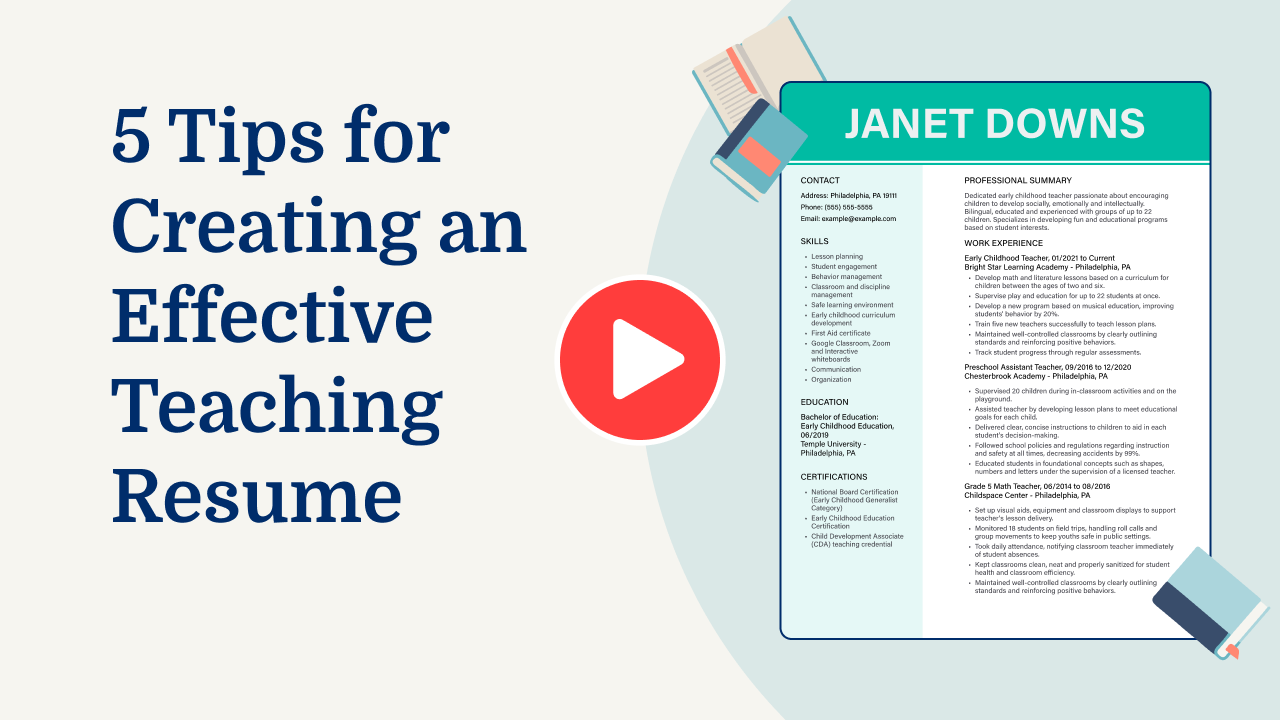
Highlight relevant certifications and training
As a high school teacher, certifications and specialized training can significantly enhance your resume. These credentials demonstrate that you have the knowledge and skills necessary to create a positive and effective learning environment.
They also show your commitment to staying current with new teaching methods, classroom technologies, and strategies to meet diverse student needs. Relevant certifications for high school teachers may include:
- State Teaching License (K–12)
- National Board Certification (NBPTS)
- TESOL/TEFL Certification (for teaching English language learners)
- Google Certified Educator (for integrating technology into instruction)
- Special Education Certification
Listing relevant certifications highlights your professional growth and readiness to take on the challenges of teaching high school students, demonstrating both expertise and dedication to your career.
Example of a certifications & training section
National Board Certification
Issued by: National Board for Professional Teaching Standards
Issued 2021
Advanced Placement (AP) Teacher Training
Issued by: College Board
Completed 2023
CPR and First Aid Certification
Issued by: American Red Cross
Expires 2024
ESL Endorsement
Issued by: State Department of Education
Issued 2020
Classroom Management Strategies Workshop
Issued by: Association for Supervision and Curriculum Development (ASCD)
Completed 2022
Looking for ideas? Check out these professional resume examples to see how different skills and jobs can be highlighted in creative ways.
List your most relevant skills
For a high school teacher, having a mix of technical and soft skills is really important. Technical skills might include knowing how to use educational software like Google Classroom or Zoom, which helps in managing classes and assignments online.
On the other hand, soft skills such as communication and patience are key when interacting with students, parents, and colleagues. These skills help create a positive learning environment and support student growth. Including a skills section on your resume can make sure these abilities stand out at first glance.
You can list specific software you are comfortable using, as well as artistic talents, if you teach subjects like art or music. But don’t just stop there; weave these skills into your work experience section too. For example, mention how you used interactive tools to engage students in lessons or how your patience helped resolve conflicts in the classroom.
This approach not only highlights what you can do but also shows how you’ve applied these abilities in real situations. It gives potential employers a clear picture of how effective you’ll be as a high school teacher.
A resume format that highlights teaching skills, classroom management, and student engagement techniques can help high school teachers stand out.
Write a strong professional summary
A professional summary on a resume acts as an introduction to hiring managers, providing a snapshot of your experience and skills. When crafting your resume, it’s essential to choose between a summary and an objective. For high school teachers, this choice can influence how potential employers perceive you.
Usually three to four sentences long, the professional summary highlights your experience, key skills, and notable achievements. It is best suited for experienced applicants who want to showcase their professional identity and the value they bring.
In contrast, resume objectives are statements that outline your career goals. They work well for entry-level applicants, those changing careers, or individuals with gaps in their work history. Next, we will provide examples of both summaries and objectives tailored to various industries and levels of experience. This guidance will help you determine the right approach for your high school teacher resume.
High school teacher resume summary examples
Entry-level
Recent graduate with a Bachelor of Science in Education, certified to teach high school mathematics. Completed student teaching experience at a diverse urban high school, developing lesson plans and engaging students in interactive learning. Passionate about fostering a positive learning environment and committed to supporting student success through innovative teaching methods.
Mid-career
Experienced high school teacher with over seven years of expertise in biology and environmental science education. Proven track record of improving student performance through tailored instruction and hands-on lab activities. Recognized for integrating technology into the classroom and collaborating with colleagues to improve curriculum development. Holds a Master’s degree in Secondary Education.
Experienced
Veteran high school educator specializing in English literature and advanced placement courses with more than 15 years of teaching experience. Known for leading successful academic teams and mentoring new teachers. Holds National Board Certification and has driven significant improvements in standardized test scores through strategic curriculum enhancements. Committed to inspiring critical thinking and lifelong learning among students.
High school teacher resume objective examples
Recent graduate
Enthusiastic recent education graduate with a Bachelor of Arts in English, seeking an entry-level high school teacher position to apply strong communication and literary analysis skills. Committed to fostering a supportive and engaging learning environment for students.
Career changer
Dedicated professional transitioning from corporate training to high school teaching, bringing expertise in developing educational content and improving student engagement. Eager to contribute creativity and discipline-specific knowledge to inspire high school students’ academic growth.
Entry-level applicant
Passionate aspiring educator with hands-on experience as a substitute teacher, aiming to secure a full-time high school teaching role. Focused on using classroom management skills and innovative lesson planning techniques to motivate students and improve educational outcomes.
Create a standout teacher resume fast! With our Resume Builder, you can easily add your teaching skills and experience to impress any school.
Showcase your accomplishments and publications
Listing your publications, conference presentations, and research accomplishments can make your resume stronger as a high school teacher. It shows you are committed to learning and sharing knowledge. This section shines a light on how much you’ve contributed to your field, making you stand out from others.
When you have peer-reviewed articles or book chapters, it proves that experts see value in what you write. Sharing conference papers demonstrates you’re active in the academic community and stay updated with new ideas. To create a publications section, list each work clearly with details like the journal name, volume, issue number, and year of publication included.
If you’ve received any major awards or grants for your work, mention them too; they add weight to your achievements. You might also want to link to online profiles such as Google Scholar or ResearchGate if you have them available.
Example of publications section
Publications
- Smith, A. (2020). Developing Effective Lesson Plans for Diverse Learners. Featured in High School Teacher Resource Guide.
- Smith, A. (2023). Engaging High School Students in STEM Through Project-Based Learning. Published in Teaching Today Magazine.
- Smith, A. (2021). Creative Approaches to Teaching Literature in High School. Presented at the Annual State Education Conference.
Choose a structured resume template with bold headings and standard fonts. Avoid cluttered visuals or intricate designs that distract from your skills and experience.
FAQ
Do I need to include a cover letter with my high school teacher resume?
Yes, including a cover letter with your high school teacher resume can set you apart from other job seekers. A cover letter allows you to express your enthusiasm for teaching while showcasing specific experiences that align with the school’s values and programs.
For instance, if the school emphasizes STEM education or arts integration, you can describe your relevant teaching experience or training in those areas.
Using our Cover Letter Generator can help you create a personalized document that complements your resume while addressing key details about the role and institution.
Exploring cover letter examples tailored to educational positions can inspire effective ways to present your qualifications and make a strong impression during the hiring process.
How long should a high school teacher’s resume be?
For a high school teacher, a one-page resume is usually sufficient to highlight your educational background, teaching certifications, and relevant experience. This format keeps it concise and focused on your key strengths as an educator.
However, if you have extensive experience or additional roles like coaching or club advising, transitioning to a two-page resume can capture these extra responsibilities effectively.
Consider exploring how long a resume should be for insights into balancing brevity with comprehensive coverage of your career achievements.
How do you write a high school teacher resume with no experience?
When crafting a high school teacher resume with no experience, focus on highlighting your education, transferable skills, and any relevant training that reflects your potential as an educator. Here are some tips to help you get started:
- Education is key: Start by listing your degree(s) in Education or related fields, including the name of the institution, graduation date, and any honors received. If you completed a teaching credential program, include this as well.
- Use student teaching: Highlight your student teaching experiences as practical examples of classroom exposure. Detail the subjects taught, grades covered, and any notable achievements or contributions during these placements.
- Showcase transferable skills: Emphasize skills applicable to teaching, such as communication, leadership, organization, and creativity. Include experiences from volunteer work or other roles where you led projects or mentored others.
For more insights on creating a compelling resume with no experience for a high school teacher position, consider reviewing additional resources that offer guidance from career experts.
Rate this article
High School Teacher
Additional Resources
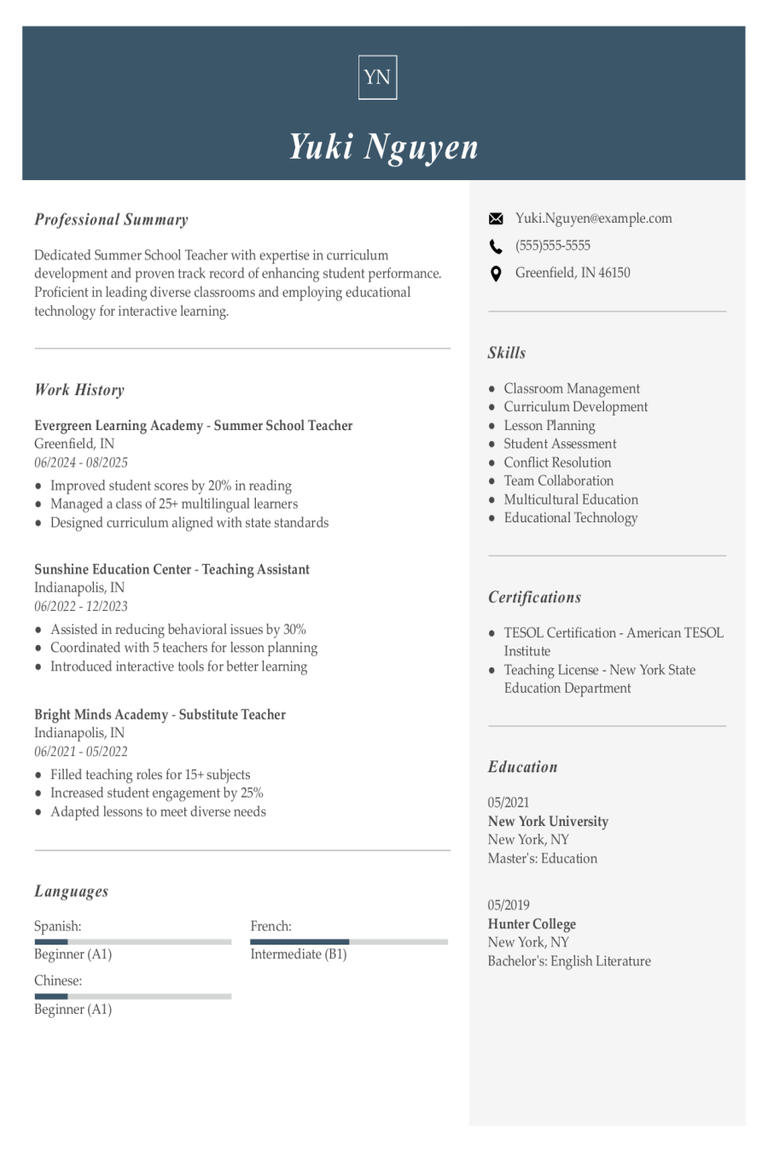
Summer School Teacher Resume Examples & Templates for 2025
Explore summer school teacher resume examples that focus on classroom management, lesson planning, and student engagement. Discover tips to show employers you’re creative, patient, and ready to inspire students.Build my
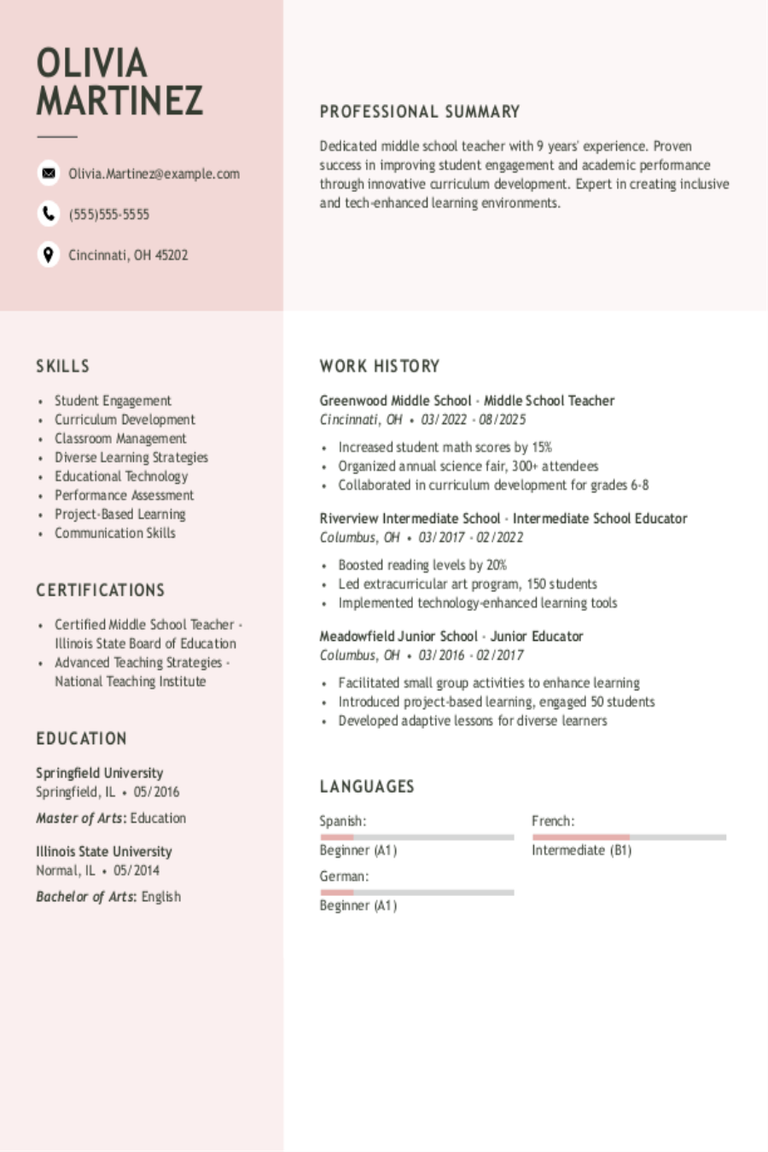
Middle School Teacher Resume Examples & Templates for 2025
Explore middle school teacher resume examples to see how to highlight your experience engaging young students, planning lessons, and managing classrooms. These examples and tips help you spotlight your teaching
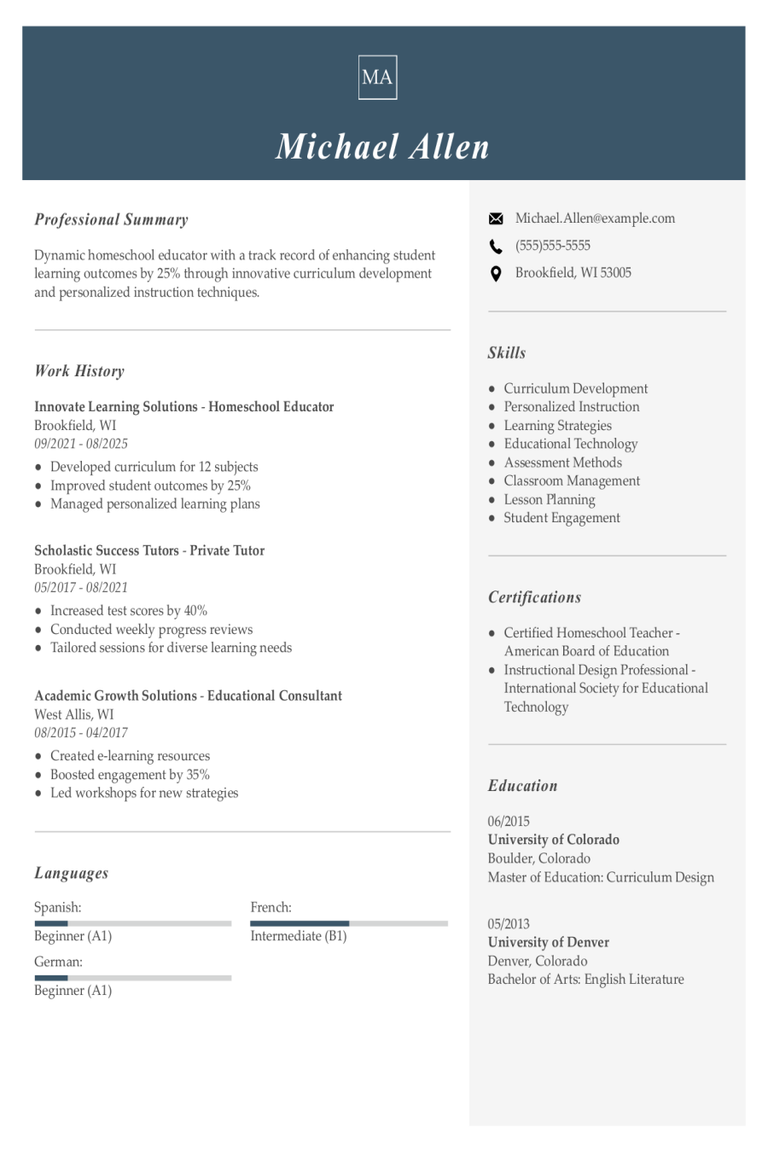
Homeschool Teacher Resume Examples & Templates for 2025
Looking to build a standout homeschool teacher resume? Our examples and tips will guide you in showcasing your teaching skills, curriculum planning, and ability to create engaging learning environments.Build my

High School Graduate Resume Examples & Templates for 2025
Explore high school graduate resume examples that show off teamwork, problem-solving skills, and part-time job experience. Learn to highlight your school projects and volunteer work to stand out to future
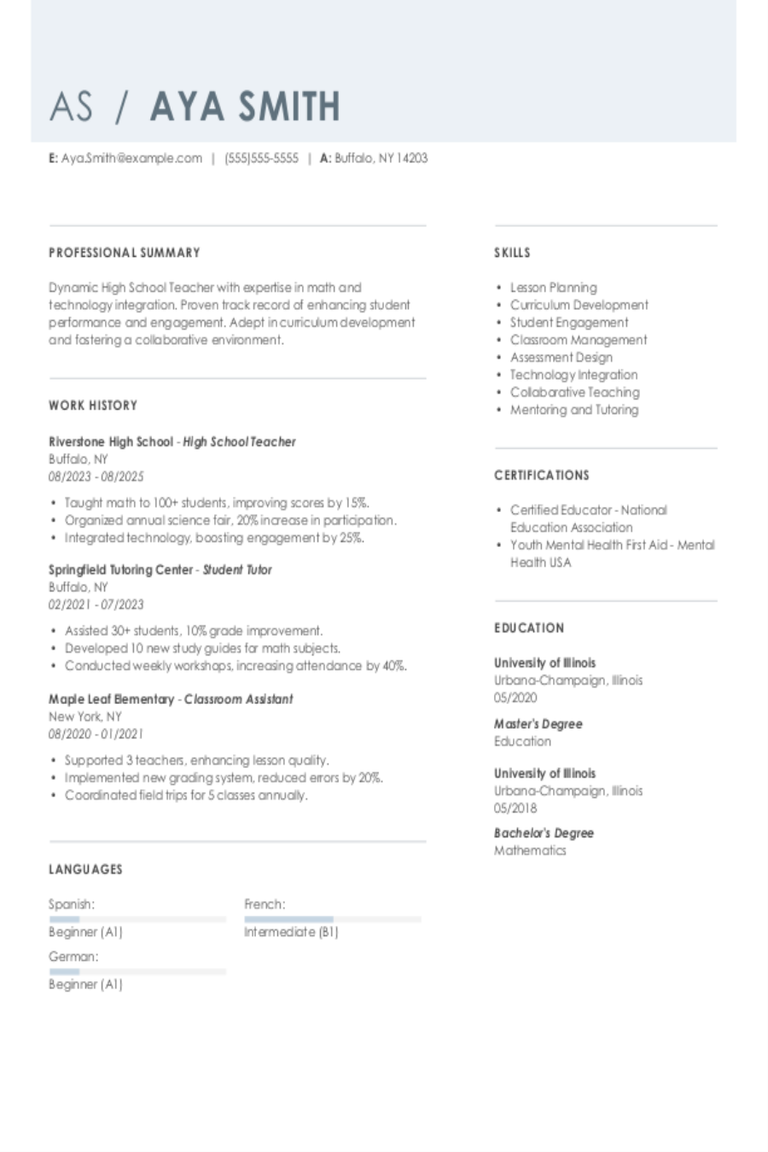
High School Resume Examples & Templates for 2025
Check out these high school resume examples to learn how to showcase your talents and reliability. Find tips on highlighting your skills and experiences in a way that stands out
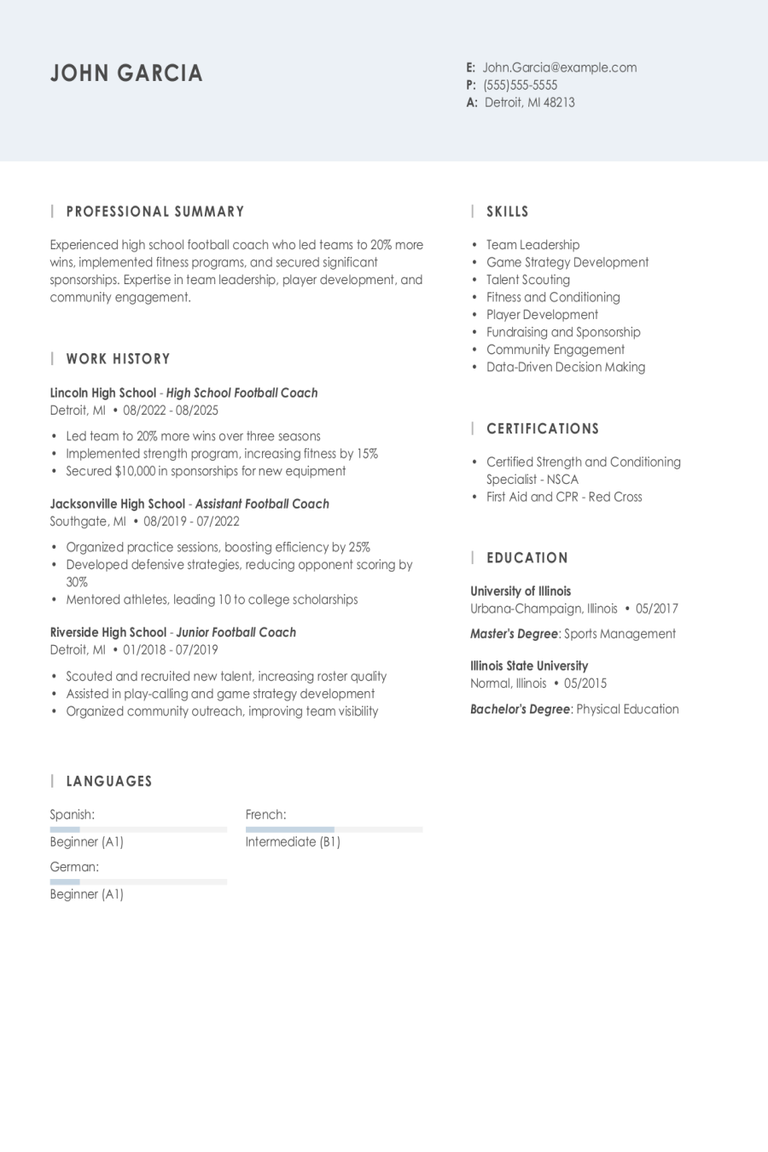
High School Football Coach Resume Examples & Templates for 2025
Browse high school football coach resume examples and learn how to show you lead a team, plan practices, and motivate players.Build my resumeImport existing resumeCustomize this templateWhy this resume
